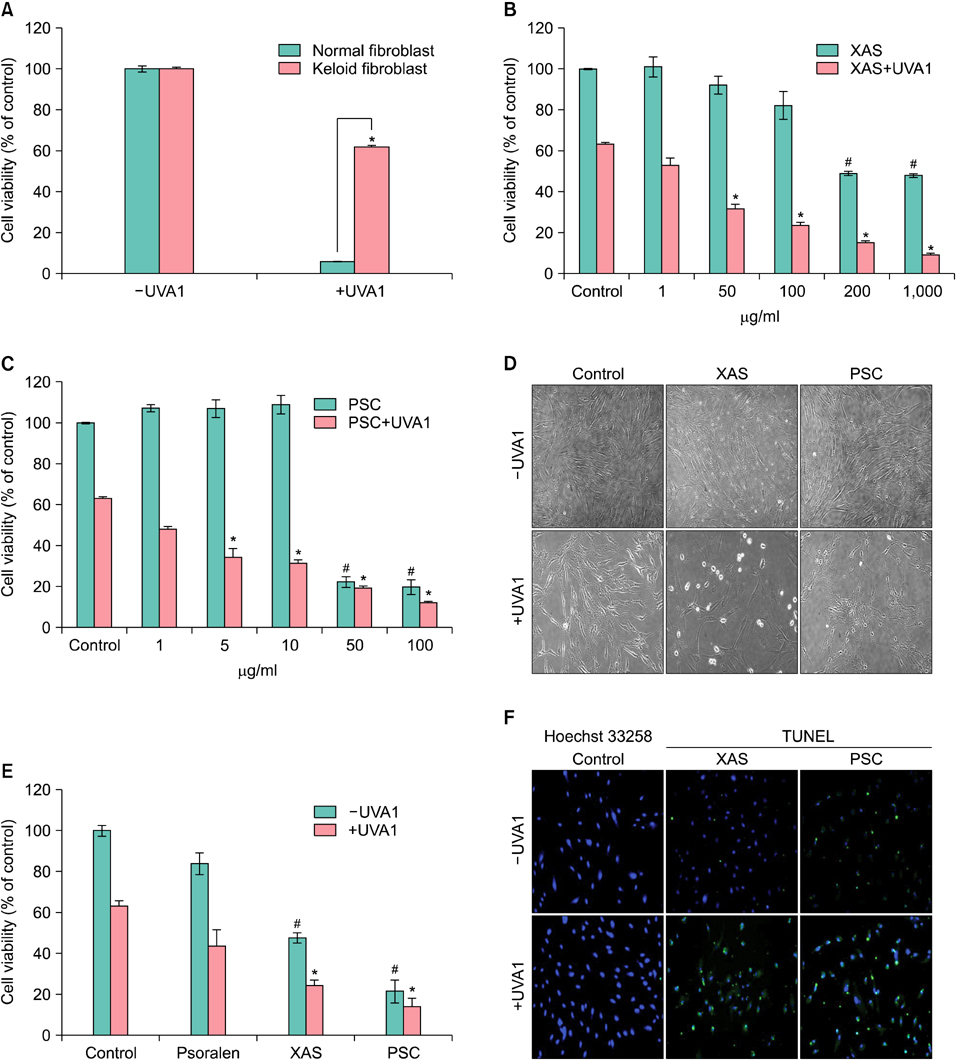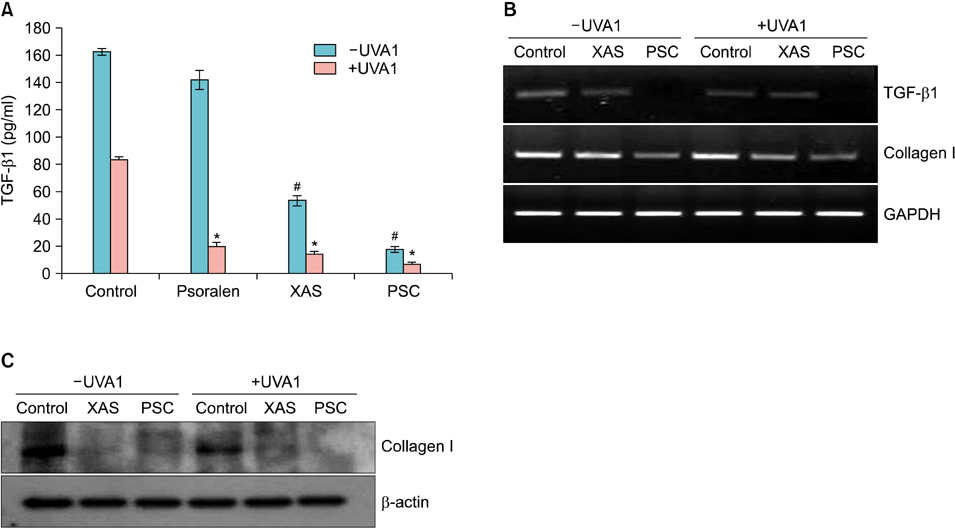Effects of Xanthium stramarium and Psoralea corylifolia Extracts Combined with UVA1 Irradiation on the Cell Proliferation and TGF-beta1 Expression of Keloid Fibroblasts
- Affiliations
-
- 1Department of Dermatology, Ajou University School of Medicine, Suwon, Korea. hykang@ajou.ac.kr
- 2Department of Otolaryngology, Ajou University School of Medicine, Suwon, Korea.
- 3Department of Microbiology, Ajou University School of Medicine, Suwon, Korea.
- 4Department of Chemical Education, Research Institute of Life Science, Gyeongsang National University, Jinju, Korea.
- 5Department of Chemistry, Research Institute of Life Science, Gyeongsang National University, Jinju, Korea.
- 6White-Line Skin Clinic & Research Center, Changwon, Korea.
- KMID: 2265869
- DOI: http://doi.org/10.5021/ad.2013.25.3.304
Abstract
- BACKGROUND
Xanthium stramarium (XAS) and Psoralea corylifolia (PSC), phototoxic oriental medicinal plants, has been used in traditional medicines in Asian countries.
OBJECTIVE
The effects of highly purified XAS or PSC extract combined with ultraviolet A1 (UVA1) irradiation on cell proliferation and transforming growth factor-beta1 (TGF-beta1) expression of the keloid fibroblast were being investigated to define potential therapeutic uses for keloid treatments.
METHODS
The keloid fibroblasts were treated with XAS or PSC alone or in the combination with UVA1 irradiation. The cell viability, apoptosis, and expression of TGF-beta1 and collagen I were investigated.
RESULTS
XAS and PSC in combination with UVA1 irradiation suppressed cell proliferation and induced apoptosis of keloid fibroblasts. Furthermore, the XAS and PSC in combination with UVA1 irradiation inhibited TGF-beta1 expression and collagen synthesis in keloid fibroblasts.
CONCLUSION
These findings may open up the possibility of clinically used XAS or PSC in combination with UVA1 irradiation for keloid treatments.
Keyword
MeSH Terms
Figure
Cited by 3 articles
-
Oxidative Damage and Nuclear Factor Erythroid 2-Related Factor 2 Protein Expression in Normal Skin and Keloid Tissue
Yoon Jin Lee, Sun Bum Kwon, Chul Han Kim, Hyun Deuk Cho, Hae Seon Nam, Sang Han Lee, Mi Woo Lee, Doo Hyun Nam, Chang Yong Choi, Moon Kyun Cho
Ann Dermatol. 2015;27(5):507-516. doi: 10.5021/ad.2015.27.5.507.Pretreatment of Ferulic Acid Protects Human Dermal Fibroblasts against Ultraviolet A Irradiation
Hyung Jin Hahn, Ki Bbeum Kim, Seunghee Bae, Byung Gon Choi, Sungkwan An, Kyu Joong Ahn, Su Young Kim
Ann Dermatol. 2016;28(6):740-748. doi: 10.5021/ad.2016.28.6.740.Low-Level Light Therapy with 410 nm Light Emitting Diode Suppresses Collagen Synthesis in Human Keloid Fibroblasts: An In Vitro Study
Hyun Soo Lee, Soo-Eun Jung, Sue Kyung Kim, You-Sun Kim, Seonghyang Sohn, You Chan Kim
Ann Dermatol. 2017;29(2):149-155. doi: 10.5021/ad.2017.29.2.149.
Reference
-
1. Gauglitz GG, Korting HC, Pavicic T, Ruzicka T, Jeschke MG. Hypertrophic scarring and keloids: pathomechanisms and current and emerging treatment strategies. Mol Med. 2011; 17:113–125.
Article2. Diao JS, Xia WS, Yi CG, Wang YM, Li B, Xia W, et al. Trichostatin A inhibits collagen synthesis and induces apoptosis in keloid fibroblasts. Arch Dermatol Res. 2011; 303:573–580.
Article3. Huang L, Wong YP, Cai YJ, Lung I, Leung CS, Burd A. Low-dose 5-fluorouracil induces cell cycle G2 arrest and apoptosis in keloid fibroblasts. Br J Dermatol. 2010; 163:1181–1185.
Article4. Hannuksela-Svahn A, Grandal OJ, Thorstensen T, Christensen OB. UVA1 for treatment of keloids. Acta Derm Venereol. 1999; 79:490.
Article5. Sunderkötter C, Kuhn A, Hunzelmann N, Beissert S. Phototherapy: a promising treatment option for skin sclerosis in scleroderma? Rheumatology (Oxford). 2006; 45:Suppl 3. iii52–iii54.6. Morison WL. Psoralen UVA therapy for linear and generalized morphea. J Am Acad Dermatol. 1997; 37:657–659.
Article7. Kerscher M, Meurer M, Sander C, Volkenandt M, Lehmann P, Plewig G, et al. PUVA bath photochemotherapy for localized scleroderma. Evaluation of 17 consecutive patients. Arch Dermatol. 1996; 132:1280–1282.
Article8. Wang Y, Hong C, Zhou C, Xu D, Qu HB. Screening antitumor compounds psoralen and isopsoralen from Psoralea corylifolia L. Seeds. Evid Based Complement Alternat Med. 2011; 2011:363052.9. Nibret E, Youns M, Krauth-Siegel RL, Wink M. Biological activities of xanthatin from Xanthium strumarium leaves. Phytother Res. 2011; 25:1883–1890.
Article10. Bark KM, Heo EP, Han KD, Kim MB, Lee ST, Gil EM, et al. Evaluation of the phototoxic potential of plants used in oriental medicine. J Ethnopharmacol. 2010; 127:11–18.
Article11. Li J, Cao J, Li M, Yu Y, Yang Y, Xiao X, et al. Collagen triple helix repeat containing-1 inhibits transforming growth factor-b1-induced collagen type I expression in keloid. Br J Dermatol. 2011; 164:1030–1036.
Article12. Scharffetter K, Wlaschek M, Hogg A, Bolsen K, Schothorst A, Goerz G, et al. UVA irradiation induces collagenase in human dermal fibroblasts in vitro and in vivo. Arch Dermatol Res. 1991; 283:506–511.
Article13. Kitamura Y, Namikawa H, Hayashi S, Yoshida T, Suzuki T, Hamasaki Y, et al. Effects of UVA irradiation following treatment with 8-methoxypsoralen on type I and type III collagen synthesis in normal and scleroderma fibroblast cultures. Arch Dermatol Res. 2009; 301:507–513.
Article14. Brinckmann J, Neess CM, Gaber Y, Sobhi H, Notbohm H, Hunzelmann N, et al. Different pattern of collagen crosslinks in two sclerotic skin diseases: lipodermatosclerosis and circumscribed scleroderma. J Invest Dermatol. 2001; 117:269–273.
Article15. Yin L, Morita A, Tsuji T. The crucial role of TGF-beta in the age-related alterations induced by ultraviolet a irradiation. J Invest Dermatol. 2003; 120:703–705.
Article
- Full Text Links
- Actions
-
Cited
- CITED
-
- Close
- Share
- Similar articles
-
- Influence of Keloid-derived Keratinocyte on TGF- beta1 Production of Fibroblast in Co-culture Model
- Anti-fibrotic Effect of Silibinin in Keloid Fibroblasts and a Bleomycin-induced, Scleroderma-like Animal Model
- A Case of Acute Cholestatic Hepatitis Caused By the Seeds of Psoralea-corylifolia
- Production of Transforming Growth Factor-beta1 in Human Fibroblasts Induced with Bacterial Toxins
- Effects of irradiation on TGF-beta1 mRNA expression and calcific nodule formation in MC3T3-E1 osteoblastic cell line



